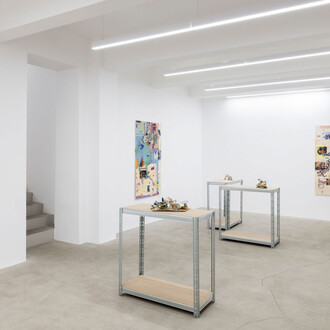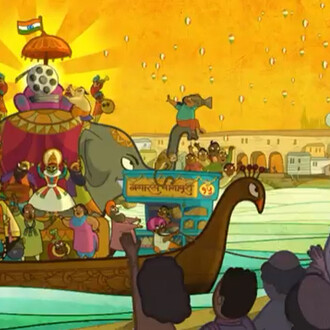Some of the best culture begins as irritation. Something — some tension or irreconcilable contradiction in the world — rubs us wrong or trips our b.s. detectors, and the only thing we can do is forcefully and truthfully respond. The b.s. often comes in the form of coded imperatives —telling us what to do, think, or like — and that forceful, truthful response is to tell them to go screw themselves in their own language. Imagine a job interview. It’s at a creative agency with exercise balls instead of desk chairs. Like everyone in the office, you’re wearing a loose button-down and some passable shoes. Your résumé is impeccably laid out, and says: experienced but not overqualified. You feel well-rested and confident. As soon as the interviewer enters the room though, everything goes to hell. He scoots your résumé to the side and wants instead to hear something interesting about yourself that makes you you. He’s only giving you enough rope to hang yourself with. Your answer, in any case, is unsatisfactory. Offering another opportunity to say the right lie, he then asks you to identify three areas in which you could use the most improvement. What’s all this about? The interviewer is rubbing his face. What’s he really looking for? On some level, he doesn’t know either. It’s something that can’t be named or measured. You exhale and your mouth starts moving as your eyes scan the room. Brick. Glass. Trademark red. Philodendron. Lexar. Beanbag. Easel. Brainstorm. Keurig cup. Fob.
You think to yourself that maybe it can’t be named because it’s not just one thing; it’s the combined force of all these things. Together they form a perfect falsity that can’t be broken down into sentence-size complaints. Likewise you know that your reaction is truthful, but in a weird sense of the word “truth.” You can’t punch through the glass partition like a psycho. It would be bad form, one — and only half-truthful. Truthful response has got to be smarter, grander, unforgettable, less of a reflex and more of an aesthetic revenge. It’s got to refuse the deeper assumptions of this place. It’s got to negate simultaneously the exercise ball, the break room, the fob, the fun vibe, your résumé, your education, his swivel chair, his unspoken displeasure at your social media presence, the insidious idea of the creative class — it has to negate all this in order to free up space for something more livable. It doesn’t even have to be negative, really — bitter, hostile, pessimistic, outright — it can negate, refuse, and criticize purely through an exercise of unauthorized autonomy. Right now the interviewer has all the power and represents the world as it is. It’s not his fault; he has a job to do. And while you may not have the power, or the job, or a job, what you do have is leisure time. After a flash of inspiration, you adopt a new plan: go to a different interview, at a new place, every day of the week, and tank it on purpose. You’ve seen this work in comedy; interviews aren’t all that different. The plan is juvenile but for you spells total freedom: scheduling interviews, acting like a bozo as a hobby or cultural practice (depending on how you look at it), and wresting back autonomy while telling this interview — this crucible of self-betrayal — to go screw itself in its own language. This is what would make you you. - Text by Brandon Joyce
Brandon Joyce is an essayist and cultural contributor, currently living in Los Angeles. He was the founder of The Philadelphia Institute for Advanced Study. He has appeared in the New York Times, National Geographic, Philadelphia Magazine, Philadelphia City Paper, Huffington Post, Rhizome, Whitewall, Paper Monument, Bad at Sports, among others. He can be found at lifeactionrevival.org.
Jill Pangallo (b. 1971 Baltimore, Maryland) lives and works in New York City. She received a MFA in Transmedia from University of Texas at Austin and a BFA in Communication Design from Parsons School of Design in New York City. Pangallo is a performer and artist best known for her funny and disturbing multimedia works that deal with identity and mass culture. She has performed and shown in, at and on a multitude of galleries, theaters, clubs and screens around the world. Pangallo has received numerous awards and accolades including grants from the University of Texas, The Idea Fund, City of Austin’s Art in Public Places and Foundation for Contemporary Arts. In 2010 she attended the Skowhegan School of Painting and Sculpture residency program and served on the alumni association and is currently on the advisory board of the Provincetown-based Afterglow Festival. She curates a variety of ensemble performance events, and has recently released Your Main Thing, a self-produced web series.
Sam Hyde (b. 1995 Capetown, South Africa) lives and works in Berlin, Germany. He studied at Cooper Union in New York City and has won numerous numerous national awards including several from The Artist’s Magazine, The Art Calendar and many juried art exhibits and competitions. He has been a featured artist in The American Artist Magazine (2005) and in American Art Collector (2007, 2009, 2011, and 2013). His work is included in national and international collections.
John Olson (b. 1972 Bismarck, North Dakota) has been pasting together a multi-colored body of work consisting of sound, mash-up words, nebulous paintings and mangled glossy magazine moments since the early 1990s. Trained as a painter, printmaker, soprano saxophonist and electrician, Olson is best known for being one-third of the seminal avant-garde tripmetal act Wolf Eyes, and for his prolific mail-order record label American Tapes (1995-2014). Olson also performs solo as Spykes, Henry and Hazel Slaughter, and with his wife, Tovah Olson, as Dead Machines. 2015 will see new releases and gigs around the world from Wolf Eyes, and ongoing releases from his new label, Imposter Complex.
Zach Shipko (b. 1989 Los Angeles, California) received his BFA at the San Francisco Art Institute in 2011. He has created hundreds of works specifically for the internet starting in the early ‘00s, cowritten/directed two feature films while attending San Francisco Art Institute, and entered the workforce as a computer programmer before starting to take street style photos around 2008.



















